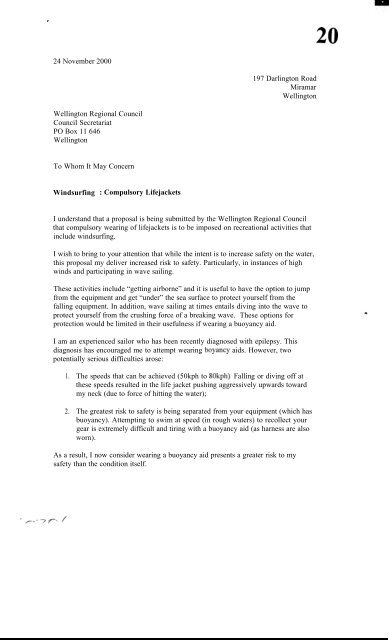Attach 4 (PDF) - Greater Wellington Regional Council
Attach 4 (PDF) - Greater Wellington Regional Council
Attach 4 (PDF) - Greater Wellington Regional Council
Create successful ePaper yourself
Turn your PDF publications into a flip-book with our unique Google optimized e-Paper software.
,<br />
24 November 2000<br />
<strong>Wellington</strong> <strong>Regional</strong> <strong>Council</strong><br />
<strong>Council</strong> Secretariat<br />
PO Box 11 646<br />
<strong>Wellington</strong><br />
To Whom It May Concern<br />
Windsurfing : Compulsory Lifejackets<br />
197 Darlington Road<br />
Miramar<br />
<strong>Wellington</strong><br />
I understand that a proposal is being submitted by the <strong>Wellington</strong> <strong>Regional</strong> <strong>Council</strong><br />
that compulsory wearing of lifejackets is to be imposed on recreational activities that<br />
include windsurfing.<br />
I wish to bring to your attention that while the intent is to increase safety on the water,<br />
this proposal my deliver increased risk to safety. Particularly, in instances of high<br />
winds and participating in wave sailing.<br />
These activities include “getting airborne” and it is useful to have the option to jump<br />
from the equipment and get “under” the sea surface to protect yourself from the<br />
falling equipment. In addition, wave sailing at times entails diving into the wave to<br />
protect yourself from the crushing force of a breaking wave. These options for<br />
protection would be limited in their usefulness if wearing a buoyancy aid.<br />
I am an experienced sailor who has been recently diagnosed with epilepsy. This<br />
diagnosis has encouraged me to attempt wearing boyancy aids. However, two<br />
potentially serious difficulties arose:<br />
1. The speeds that can be achieved (50kph to 80kph). Falling or diving off at<br />
these speeds resulted in the life jacket pushing aggressively upwards toward<br />
my neck (due to force of hitting the water);<br />
2. The greatest risk to safety is being separated from your equipment (which has<br />
buoyancy). Attempting to swim at speed (in rough waters) to recollect your<br />
gear is extremely difficult and tiring with a buoyancy aid (as harness are also<br />
worn).<br />
As a result, I now consider wearing a buoyancy aid presents a greater risk to my<br />
safety than the condition itself.<br />
20
















